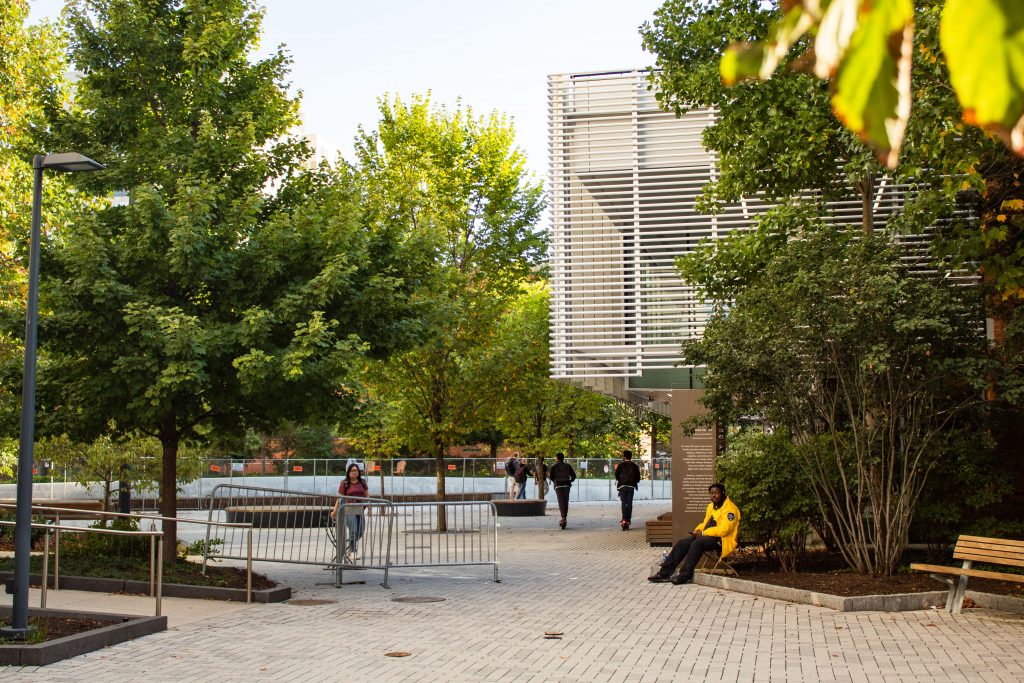
On a typical fall term day where the weather permits, the gray brick paths, wooden benches, bright green trees and the always popular elevated turf of the Korman Family Quad are brightened by the image of students stretched out on blankets or sitting in the chairs, laptops and books open, soaking up the last few weeks of sunshine before the winter months come. This year, the words, “No Trespassing” and “Private Property” are posted every few feet along chain link fences surrounding the perimeters of every grassy space within the Quad. For these first two weeks of Fall term, students have been filling in on the few benches that remain unfenced and the turf lays dormant, untouched grass bothered by nothing other than falling leaves and a few occasional birds.
A September 9th email from exiting President John Fry explains that the measure to fence in the area was “to discourage trespassing and to prevent outside activists or protesters from setting up prohibited encampments at the heart of campus.” The message defends the University’s recognition of dissent and peaceful protest as crucial for sparking intellectual debate, challenging norms, and highlighting injustices and crises. It should not be a challenge for students to trust that the administration is making difficult decisions for the student body in good faith, and this message may be true according to university policy. However, to the students passing by each day and reading the signs posted on the fences and barricades in Korman Quad, they are not more than words in an email. The true impact of the decision may be much greater.
The purpose of this piece is not to take a stance on whether or not the motivation behind erecting the fences was justified, nor does it agree or disagree with the University’s statement that the cause of the decision was “conduct that crossed the line between peaceful protests and unlawful harassment, discrimination and destruction of property.” Instead, it argues that the choice to limit access to the greenspaces on Korman Quad has a much greater, unintended impact: it damages the student perception of both the culture of free speech on campus and the apparent value of student wellness to the administration.
Tuition-paying students are passing these fences each day and reading signs that tell them not to trespass– on their own campus. The interpretation of this may be detrimental to the student body’s image of their own right to speak out– the response to demonstrations, peaceful or otherwise, it might appear, is to shut parts of campus down indefinitely. This decision has the potential to inspire hesitation in students to speak up about anything at all, knowing what the punishment for doing so may be.
Less directly, but just as importantly, is the impact that reducing access to greenspace on campus has on the wellbeing of students. Cities feel the benefits of greenspaces keenly– they’re known to reduce crime rates and improve mental and physical health, along with having countless environmental benefits. Students recently felt the loss of Buckley Field, now the site of construction for a life sciences research facility, and will soon gain a new recreational field in the plot where Myers Hall stood prior to its recent demolition. While the campus certainly has a distinct city charm, constant construction in every main sector of campus is draining to be around. This has a profound impact on students who have fewer places to relax outside between classes– particularly commuters or students who live off-campus. Reducing the amount of available greenspace is only making this problem worse.
This is a complex and sensitive decision, and one that must be addressed with care. There are surely students who believe the fences standing in Korman Quad are a necessary safety measure, just as there are surely some who find them useless and upsetting. However, as of right now, there is no definite timeline for this. There is already limited communication on the existence of the measure and little to no context for our newer students, who have not seen campus another way. It is concerning that there is no confirmation of how much longer this will go on for, but even more concerning and dangerous is the lack of attention given to the long-term impact this decision may have on student morale and trust in the administration.


